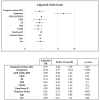Does Gender Influence the Indication of Treatment and Long-Term Prognosis in Severe Aortic Stenosis?
- PMID: 36826534
- PMCID: PMC9963043
- DOI: 10.3390/jcdd10020038
Does Gender Influence the Indication of Treatment and Long-Term Prognosis in Severe Aortic Stenosis?
Abstract
Introduction: It is a matter of controversy whether the therapeutic strategy for severe aortic stenosis (AS) differs according to gender.
Methods: Retrospective study of patients diagnosed with severe AS (transvalvular mean gradient ≥ 40 mmHg and/or aortic valvular area < 1 cm2) between 2009 and 2019. Our aim was to assess the association of sex on AVR or medical management and outcomes in patients with severe AS.
Results: 452 patients were included. Women (51.1%) were older than men (80 ± 8.4 vs. 75.8 ± 9.9 years; p < 0.001). Aortic valve replacement (AVR) was performed less frequently in women (43.4% vs. 53.2%; p = 0.03), but multivariate analyses showed that sex was not an independent predictor factor for AVR. Age, Charlson index and symptoms were predictive factors (OR 0.81 [0.82-0.89], OR 0.81 [0.71-0.93], OR 22.02 [6.77-71.64]). Survival analysis revealed no significant association of sex within all-cause and cardiovascular mortalities (log-rank p = 0.63 and p = 0.07). Cox proportional hazards analyses showed AVR (HR: 0.1 [0.06-0.15]), Charlson index (HR: 1.13 [1.06-1.21]) and reduced LVEF (HR: 1.9 [1.32-2.73]) to be independent cardiovascular mortality predictors.
Conclusions: Gender is not associated with AVR or long-term prognosis. Cardiovascular mortality was associated with older age, more comorbidity and worse LVEF.
Keywords: aortic valve replacement; aortic valve stenosis; mortality; sex differences; treatment outcome.
Conflict of interest statement
The authors declare no conflict of interest.
Figures




Similar articles
-
Tricuspid Regurgitation Is Associated With Increased Risk of Mortality in Patients With Low-Flow Low-Gradient Aortic Stenosis and Reduced Ejection Fraction: Results of the Multicenter TOPAS Study (True or Pseudo-Severe Aortic Stenosis).JACC Cardiovasc Interv. 2015 Apr 20;8(4):588-96. doi: 10.1016/j.jcin.2014.08.019. Epub 2015 Mar 26. JACC Cardiovasc Interv. 2015. PMID: 25819185
-
Aortic valve replacement in isolated severe aortic stenosis with left ventricular dysfunction: long-term survival and ventricular recovery.Anadolu Kardiyol Derg. 2009 Feb;9(1):41-6. Anadolu Kardiyol Derg. 2009. PMID: 19196573
-
Atrial fibrillation is not an independent predictor of outcome in patients with aortic stenosis.Heart. 2020 Feb;106(4):280-286. doi: 10.1136/heartjnl-2019-314996. Epub 2019 Aug 22. Heart. 2020. PMID: 31439661 Free PMC article.
-
Patient survival in severe low-flow, low-gradient aortic stenosis after aortic valve replacement or conservative management.J Card Surg. 2021 Mar;36(3):1030-1039. doi: 10.1111/jocs.15209. Epub 2020 Dec 18. J Card Surg. 2021. PMID: 33336497 Free PMC article. Review.
-
[The best of valvular heart disease in 2006].Arch Mal Coeur Vaiss. 2007 Jan;100 Spec No 1:19-28. Arch Mal Coeur Vaiss. 2007. PMID: 17405561 Review. French.
Cited by
-
Longitudinal Outcomes of Patients with Aortic Stenosis Stratified by Sex: An Asian Perspective.J Cardiovasc Dev Dis. 2025 Jan 19;12(1):32. doi: 10.3390/jcdd12010032. J Cardiovasc Dev Dis. 2025. PMID: 39852310 Free PMC article.
-
Advanced Cardiac Imaging in the Assessment of Aortic Stenosis.J Cardiovasc Dev Dis. 2023 May 14;10(5):216. doi: 10.3390/jcdd10050216. J Cardiovasc Dev Dis. 2023. PMID: 37233183 Free PMC article. Review.
References
-
- Lung B., Delgado V., Rosenhek R., Price S., Prendergast B., Wendler O., De Bonis M., Tribouilloy C., Evangelista A., Bogachev-Prokophiev A., et al. Contemporary Presentation and Management of Valvular Heart Disease. Circulation. 2019;140:1156–1169. doi: 10.1161/CIRCULATIONAHA.119.041080. - DOI - PubMed
LinkOut - more resources
Full Text Sources
Research Materials

